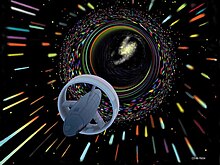List of science fiction themes
 |
| Speculative fiction |
|---|
|
|

The following is a list of articles about recurring themes in science fiction.
Overarching themes
- First contact with aliens
- Artificial intelligence
- Extraterrestrials in fiction
- End of humanity: Apocalyptic and post-apocalyptic fiction
- The future
- Apocalyptic and post-apocalyptic fiction: Apocalypses or worldwide disasters and new societies that develop after the event
- History
- Alternate history
- Scientific prediction of the future (e.g. psychohistory)
- Human fears: List of science fiction horror films
- Language
- Alien languages (e.g. Klingon, Huttese)
- The Sapir–Whorf Hypothesis (e.g. Babel 17, The Languages of Pao)
- Universal translators (e.g. Babel fish)
- Military/conflicts
- Parallel worlds or multiverse
- Philosophies and philosophical ideas
- Sex and sexuality
- Simulated reality and consciousness
- Social science fiction
- Technological singularity
- Themes of fantasy fiction
Beings and entities
- Artificial intelligences
- Characters
- Clones
- Dinosaurs
- Extraterrestrial life
- Hypothetical types of biochemistry
- Alien invasion
- Astrobiology
- God-like aliens
- Principles of non-interference (e.g. Prime Directive)
- Message from space
- Living planets (both sentient and non-sentient)
- Hive minds
- Infomorphs—memories, characters, and consciences of persons being uploaded to a computer or storage media
- Mutants
- Shapeshifters
- Superhumans
- Superorganisms
- Symbionts
- UFOs
- Uplifting—using technology to "raise" non-human animals to human evolutionary levels
Body and mind alterations
- Biohacking/Amateur biotechnicians
- Artificial organs
- Additional or improved senses[page needed]
- Cloning
- Exocortex
- Genetic engineering
- Intelligence amplification
- Invisibility
- Life extension, Biological immortality, Universal immortalism and immortality
- Prosthetics
- Memory
- Psi powers and psychic phenomena
- Parasitism[1][2][3][4][5]
- Psychedelia
- Resizing (size-changing, miniaturization, magnification, shrinking, and enlargement)
- Shapeshifting
- Superhuman strength
- Teleportation
- Transhumanism and Posthumanism
Habitats
- Artificial worlds
- Alien Zoo—a zoo where humans are kept as exhibits
- Arcologies—enormous habitats (hyperstructures) of extremely high human population density
- Cyberspace—the new, virtual territory of societal interaction
- Domed city
- Floating city
- Future of the Earth
- Climate change—science fiction dealing with effects of anthropogenic climate change and global warming at the end of the Holocene era
- Megacity
- Pastoral science fiction—science fiction set in rural, bucolic, or agrarian worlds, either on Earth or on Earth-like planets, in which advanced technologies are downplayed.
- Seasteading and ocean colonization
- Reality Television
- Space colonization
- Space stations and habitats
- Underground city
Political themes
- Adhocracy
- Anarcho-capitalism
- Capitalism
- Cognitive liberty
- Dystopias and utopias
- Galactic empires
- Government by algorithm
- Legal personality
- Libertarianism
- Mass surveillance
- Mind reading and mind control
- National security state
- Post-scarcity economy
- Socialism
- Technoethics
- Technophobia
- Techno-progressivism
- Terrorism
- Totalitarianism vs. Libertarianism
Technologies
- Artificial gravity
- Artificial intelligence
- Asteroid mining
- Astronomical engineering
- Brain–computer interface
- Cloaking device
- Emerging technologies
- Robots
- Self-replicating machines
- Simulated reality
- Star lifting and stellar engineering
- Stasis device
- Total conversion as energy source
- Mecha
- Megascale engineering and planetary engineering
- Molecular manufacturing and Nanotechnology
- Alien technology
- Virtual reality, mixed reality, augmented reality
- Weapons in science fiction
Travel
- Accidental travel
- Colonization of other planets, moons, asteroids, etc.
- Space exploration
- Interstellar travel/Starships
- Faster-than-light travel and communications
- Close to light speed
- Bussard ramjets
- Ursula K. Le Guin's NAFAL ships, and the Twin paradox
- Much slower than light
- Space stations
- Interstellar travel/Starships
- Teleportation
- Time travel
- Alternate history: time travel can be used as a plot device to explore parallel universes. While alternate history has its own category (see above), it often occurs in time travel stories as well.
- Alternate future
- Time loop
- Travel to the Earth's center
See also
References
- ^ "Parasitism and Symbiosis". The Encyclopedia of Science Fiction. 10 January 2016.
- ^ Guarino, Ben (19 May 2017). "Disgusting 'Alien' movie monster not as horrible as real things in nature". The Washington Post.
- ^ Glassy, Mark C. (2005). The Biology of Science Fiction Cinema. McFarland. pp. 186 ff. ISBN 978-1-4766-0822-8.
- ^ Moisseeff, Marika (23 January 2014). Aliens as an Invasive Reproductive Power in Science Fiction. pp. 239–257.
{{cite book}}:|website=ignored (help) - ^ Williams, Robyn; Field, Scott (27 September 1997). "Behaviour, Evolutionary Games and .... Aliens". Australian Broadcasting Corporation. Retrieved 30 November 2017.
